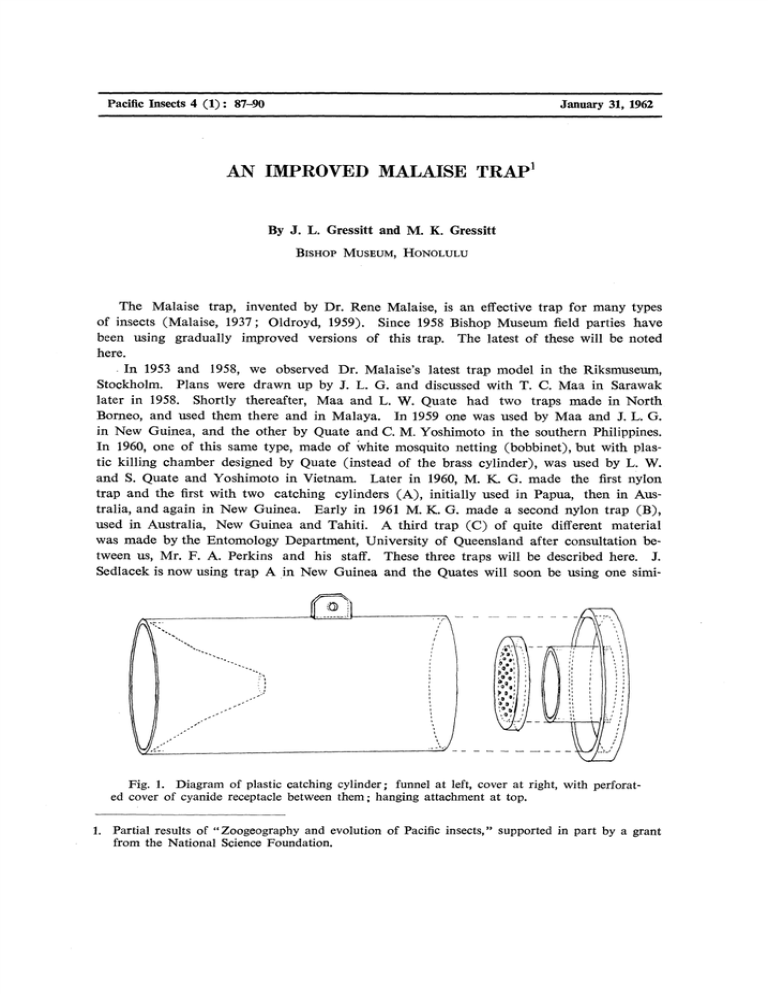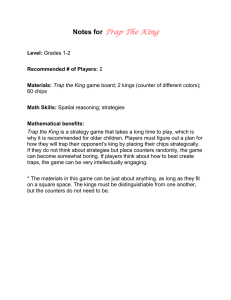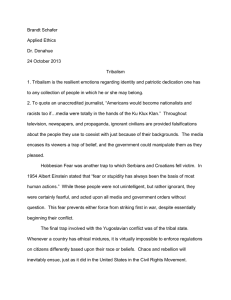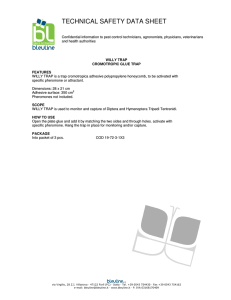an improved malaise trap1
advertisement

Pacific Insects 4 ( 1 ) : 87-90 January 31, 1962 AN IMPROVED MALAISE TRAP1 By J. L. Gressitt and M. K. Gressitt BISHOP MUSEUM, HONOLULU The Malaise trap, invented by Dr. Rene Malaise, is an effective trap for many types of insects (Malaise, 1937; Oldroyd, 1959). Since 1958 Bishop Museum field parties have been using gradually improved versions of this trap. The latest of these will be noted here. In 1953 and 1958, we observed Dr. Malaise's latest trap model in the Riksmuseum, Stockholm. Plans were drawn up by J. L. G. and discussed with T. C. Maa in Sarawak later in 1958. Shortly thereafter, Maa and L. W. Quate had two traps made in North Borneo, and used them there and in Malaya. In 1959 one was used by Maa and J. L. G. in New Guinea, and the other by Quate and C. M. Yoshimoto in the southern Philippines. In 1960, one of this same type, made of white mosquito netting (bobbinet), but with plastic killing chamber designed by Quate (instead of the brass cylinder), was used by L. W. and S. Quate and Yoshimoto in Vietnam. Later in 1960, M. K. G. made the first nylon trap and the first with two catching cylinders (A), initially used in Papua, then in Australia, and again in New Guinea. Early in 1961 M. K. G. made a second nylon trap (B), used in Australia, New Guinea and Tahiti. A third trap (C) of quite different material was made by the Entomology Department, University of Queensland after consultation between us, Mr. F. A. Perkins and his staff. These three traps will be described here. J. Sedlacek is now using trap A in New Guinea and the Quates will soon be using one simi- Fig. 1. Diagram of plastic catching cylinder; funnel at left, cover at right, with perforated cover of cyanide receptacle between them; hanging attachment at top. 1. Partial results of "Zoogeography and evolution of Pacific insects," supported in part by a grant from the National Science Foundation. 88 Pacific Insects Vol. 4, no. 1 lar to trap B there. Trap A. This is of black nylon organdie (34 strands per cm), with two plastic catch- .tfiH Fig. 2. a, trap A in Eucalyptus savanna woodland at Moggill Farm (University of Queensland), near Brisbane, S. Queensland, Jan. 1961; b, trap B in rain forest, Mt. Glorious, near Brisbane, Feb. 1961; Margaret Gressitt behind center panel in both pictures. 1962 Gressitt & Gressitt: Malaise trap 89 ing cylinders. The net consists essentially of a central median panel 7 m long and 3.6 m high, with end panels 1.8 m wide at right angles to it and slightly sloping roof-panels or awnings on each side of its top edge. Thus each face of the median panel is a 3walled, slope-roofed shelter; and the whole net is like a typical ridge-pole house, but with a median panel instead of side walls. Panels 0.2 m wide border the roof and side panels, inwardly, to discourage insects from escaping. At each end of the upper corners of the median panel (or at the gable of the roof) the joined roof panel and end panel are extending to form a partial cone leading to a plastic catching cylinder. The cylindrical small end of the cone fits very tightly around the open end of the plastic cylinder. A strong rope forms the ridge-pole support of the median panel and roof panels, and also supports the plastic cylinders before continuing on out as the means of suspension of the entire trap. This rope is run over a tree branch of appropriate height and location and tied to a low branch or tree-trunk. Two smaller cords support the outer edge (eaves) of the roof panels, passing along them and continuing from the 4 corners of the top of the net. These cords are tied to trees or branches of appropriate height, or when necessary fastened on the ground at considerable distance. At the lower edge of each end-panel, cords at the two corners and at the median junction with the median panel are used to tie it close to the ground (to roots, stakes, or low shrubs). A double strip of heavy black cotton poplin 0.3 m wide reinforces the lower edge of the median panel and by its weight helps the net stay in position. Grommets, with cords, along its bottom edge are used for attachment in windy weather or in exposed situations. Trap B is of green nylon organdie. It is 5 m long and 3.5 m high. It differs otherwise from Trap A in having a floor of heavy green cotton poplin meeting the lower edges of the median panel and end panels. The outer edge of the floor panel is folded upward and inward at the sides and can be to some extent maintained in this position by tight fastening of the corners or putting objects like rocks or small logs on the floor. The reason for the floor, and an added reason for placing rocks, logs, bark or leaves upon it, is to catch more beetles. In general, most beetles tend to fall to the ground on flying against the center panel, and many of them fail to fly or climb upward to the more elevated corners and into the catching cylinders like most flying insects. Some beetles tend to hide under the objects placed on the floor, or in the corners. Further improvements are contemplated to make the trap more effective in catching beetles. The floor panel contributes also to stabilization and shape-support, and prolongs the life of the trap. Also, this trap has been used off the ground supported high in trees or over narrow ravines. Trap C. This is of similar size and proportions to Trap A, but is of much stronger build. It is made of nylon horsehair (stiffened; marquisette type weave) of 7.7x9 strands per cm. It is reinforced with light canvas along the ridge pole, main seams and edges, and with a strip horizontally across the middle of the center panel. Otherwise, it is similar to Trap A, but is more durable (trap A was severely damaged in a storm after some months use, and needed major repair). Drawbacks of Trap C are that it is rather heavy, requiring strong support, and that it fails to catch many minute insects which can escape through the rather coarse weave. Cylinders: The transparent plastic catching cylinders are each 22 X 10 cm, with a builtin funnel at the entrance end. The inner opening of the funnel is about 12 or 15 mm in diameter. This may be varied according to the type of insects particularly desired. The 90 Pacific Insects Vol. 4, no. 1 smaller the opening, the quicker the insects are killed, which reduces the amount of damage to fragile insects from larger and later entrants. The 12-15 mm opening excludes dragon flies, large butterflies and moths, and some other large insects. However, unexpectedly large tettigoniids and beetles, with body diameter practically as large as the opening, have gained entry. Never has an opening been found obstructed except with filling of the cylinder with specimens until they commence to slide out of the funnel. That would mean a catch of perhaps 3,000 specimens. The end opposite the cone is removable; to its inner surface is attached a small, cylindrical receptacle with a perforated, removable cap to hold the cyanide. About 3 cubic centimeters of cyanide wrapped with cellucotton or absorbent paper to absorb excess moisture will last for several days. Placement: Strategic placement of the Malaise trap is important. It should be set up where insect flight tends to be concentrated by local circumstances of topography, density or lack of vegetation, relation to wind, water and such aspects. Suitable places are across a small stream or gully, across a wide trail in the forest, at a low pass on a ridge, between two types of vegetation, in a clearing, plantation or savanna woodland at right angles to edge of adjoining dense rain forest, or at an opening to a clearing. Results: When placed in favorable situations, all the above traps gave excellent results. Catches in good locations at a favorable season were often well over 1,000 specimens per trap per day. One of the attributes of this type of trap is that it functions satisfactorily in rainy as well as sunny weather. Rain does not enter the catching cylinder, so that specimens become damp only from steaming action of sun on large catches of insects. This is partly counteracted by placing a sheet or two of absorbent paper on the inside of the cylinder. Another attribute of the trap is that it functions continuously and catches most types of flying insects. Its catch at night may be very similar to that of a light trap, as it catches insects which are abroad on the wing and happen to fly into it. It also may function as a light trap by hanging a lantern on one side of it with the light on the side opposite the more favorable direction. The catch is generally in better condition than in most light traps. The trap may be left untended for a few days, although it is desirable to tend it more often—preferably daily at dawn and dusk to separate day from night catches. The majority of insects trapped are active flyers. Thus, Hymenoptera are often best represented in catches. Diptera often exceed Hymenoptera in numbers. Lepidoptera are generally third and others are represented more sparingly, but Trichoptera, Homoptera and Heteroptera are sometimes abundant in catches. Groups often taken abundantly are Pompilidae, Apoidea, Ichneumonoidea, Formicoidea, various Nematocera, Tabanidae, Syrphidae, Muscoidea, Cicadelloidea, Miridae, and others. On some occasions several hundred bees, ants or tabanids have been taken in one day's catch. Acknowledgements: Much credit for the improvement and production of traps is due T. C. Maa, L. W. Quate, C. M. Yoshimoto, Dorothy Rainwater and Setsuko Nakata. LITERATURE CITED Malaise, Rene. 1937. A new insect-trap. Entomologisk Tidskrift, Stockholm. 5 8 : 148— 60, figs. Oldroyd, Harold. 1950. Collecting, preserving and studying insects. Hutchinson Sci. & Techn., London, pp. 57-9, figs. 32-4.




